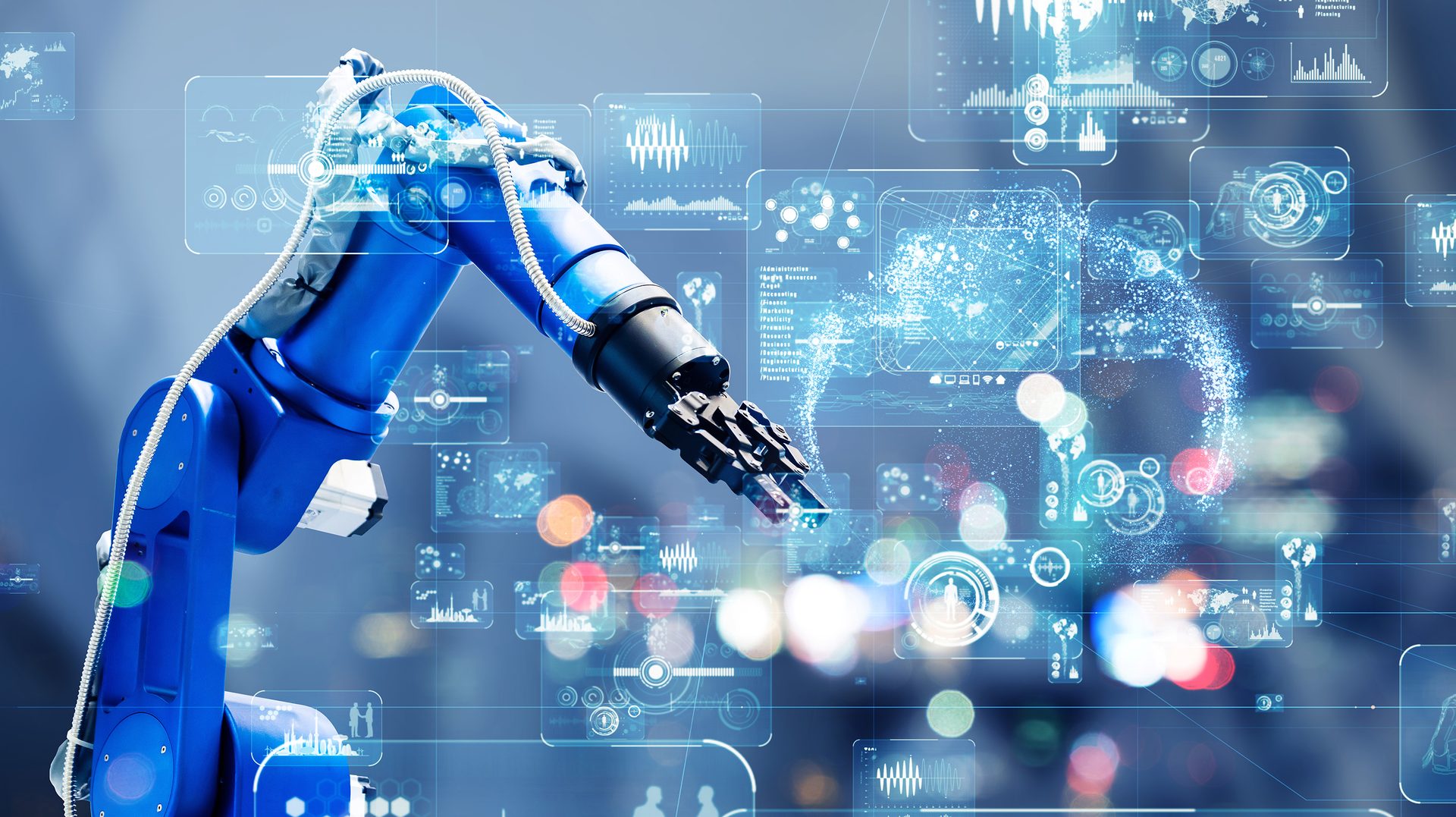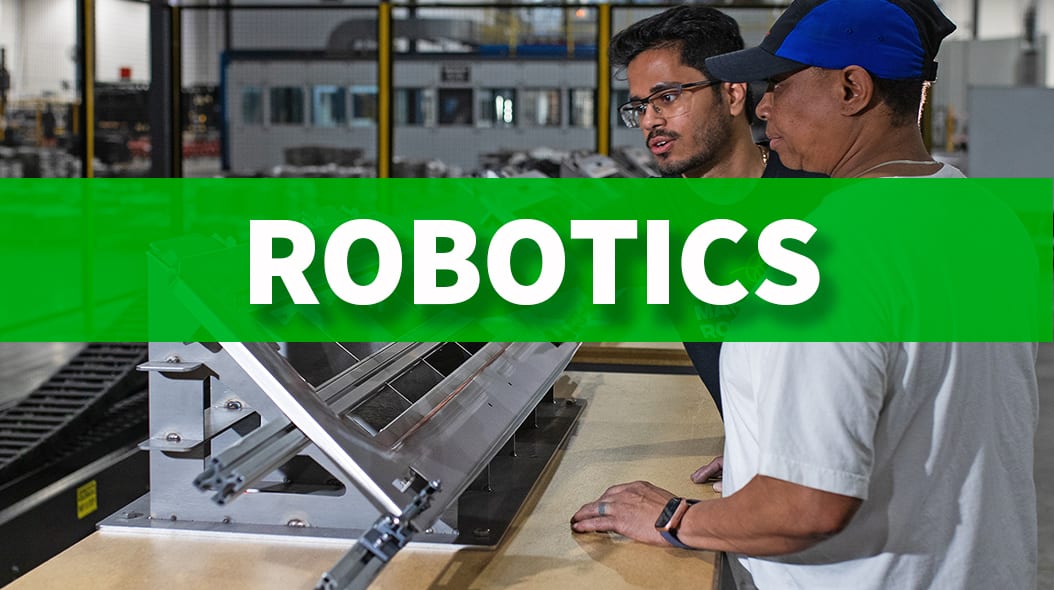Machine Learning
Vision & Sensors
V&S
H2 Deck By Bold Name
h2 xxxxxx
H1 xxxxxx
h2 xxxxx

By “intelligent evolution,” I’m not talking about the simple adoption of automation and forms of machine learning, sort of a set-it-and-forget-it approach. By Brent Lazarenko
Manufacturing Evolution:
The Intelligent Automation Revolution
If you picture the manufacturing floor just five years ago, let alone a few decades ago, it looks very different from today. That’s because intelligent machines—such as robotics and automation tools—are now working alongside humans in environments that prize collaboration, speed, and efficiency.
Using artificial intelligence (AI) and predictive analytics, manufacturers are now able to decrease equipment failures and predict when they will occur and optimize physical systems to meet real-time needs. All of this contributes to more effective manufacturing production, but what is taking place isn’t just about increased automation—it represents a larger upending of traditional manufacturing norms to embrace a new landscape of intelligent evolution.
What is Intelligent Evolution?
By “intelligent evolution,” I’m not talking about the simple adoption of automation and forms of machine learning, sort of a set-it-and-forget-it approach. Instead, I’m referring to how companies are searching for new ways to “intelligently” introduce machine learning, AI, predictive analytics, and automation into every possible space for improvement along the manufacturing journey—from design inception to production, to quality control and packaging, to logistical delivery to customers.
Intelligent evolution is about strategically using machine learning technologies like AI to iterate and simplify the assembly, quality assurance, and shipping processes within an organization. Anything that could use improvement gets improved, even the process by which improvements are identified. Using AI-driven models to identify areas for efficiency is just the start. Evolution, therefore, is inevitable when intelligent systems enter the fold.
When you consider the disruptions the manufacturing industry has experienced following the COVID pandemic, it’s apparent how supply chains are still recovering. Companies have been strategizing ways to improve data analysis and the flow of materials for production and delivery, making new investments in automation and predictive processes to build a more resilient posture for the post-pandemic era. The limitations of previous decades are now being addressed through robotic dexterity, advances in machine learning, data analysis, and automation for complex tasks—all of which would have historically been viewed as impossible. It’s a testament to the evolutionary power of how technology can improve human standards of operation.

Source: metamorworks / iStock / Getty Images Plus via Getty Images.
Intelligent Machines Are Growing at Rapid Pace
According to a 2023 McKinsey report, “half of today’s work activities could be automated between 2030 and 2060.” This means that the manufacturing industry is standing at the precipice of a comprehensive reordering, one that will shift the very make-up of what modern-day production looks like. The concern, here, isn’t that such evolution is taking place. Indeed, change is inevitable.
What I advocate businesses should be looking at now, rather than putting it off any longer, is how current jobs and roles in their existing workforce will evolve to fit the emerging needs of this new manufacturing landscape. It’s better to prepare so that your star personnel can get educated for the evolutionary shifts on the horizon.
Some current roles will be automated away, whereas new ones will be created in their place. This is always the fear among workers. It’s incumbent on business leaders to assure the workforce that they are planning now to alleviate pain points later. Indeed, this approach will also help retain the very best of your skilled workforce during this evolutionary period to ensure you remain competitive on the other side, utilizing your most talented folks in new ways to accomplish core goals.
The new market already taking shape for manufacturing is huge. According to a report from Research & Markets, “The global industrial control & factory automation market was valued at $255.88 billion in 2024 and is projected to reach $399.12 billion by 2029; it is expected to register a CAGR of 9.3%.” This means that the industry will become much more lucrative as it automates further.
How to Embrace Change Without Falling Behind
The future of a business will depend largely upon how agile workforces can remain during these massive changes. As I mentioned, such evolution is inevitable—how well prepared you are will dictate how well you fare. This takes continuous alignment between organizational leadership, board members and investors, and the business departments upon which all operations rely.
Because of the emergence of AI technology, the manufacturing industry has entered a new era of getting things made and shipped. The companies that can facilitate and adapt to any changes needed to their existing processes will not only see major revenue gains, but also more efficient avenues to creating that revenue. Similarly, the workers who anticipate how this evolution could benefit their careers will likely see those benefits.
It’s the role of business executive leadership to prep their existing workforce for the introduction of more intelligent machines, educating them for the future. Automation doesn’t need to be a scary endeavor. Instead, it should be viewed as force to improve the work already at-hand, empowering skilled professionals to focus on other, more impactful areas of design, production, quality assurance, and supply chain logistics. It’s about career growth rather than stagnation or job loss.
One of the keys to a successful evolution toward AI is a deep understanding of how to maximize the technology. You can’t just fire up an AI-powered tool and walk away. The integration of AI must be woven into the fabric of your organization to enhance efficiency, drive innovation, and create value. AI usage should be specifically tailored to your organization and its use cases for the tech. View it as a strategic integration across business practices rather than just a plug-and-play solution. AI can impact every aspect of your business if you let it, but you must ensure all AI systems are transparent and accountable to align with ethical considerations. With these things in mind, you can leverage AI to turn potential challenges into growth opportunities.
If you are worried about how well-suited your manufacturing company currently is to tackle the necessary changes for embracing AI and other models of predictive analytics and automation, having a managed service provider (MSP) by your side could be useful. An MSP can help in navigating this period of uncertainty, strategizing the adoption of new systems and how to retire old systems. Even just having a consultant to bring in when your organization hits a wall or wants a second opinion before implementing a new solution, an MSP is a good third-party to leverage. All these aspects contribute holistically to your organization’s strategic posture, and how well operations can continue unhindered, despite what changes are occurring.
